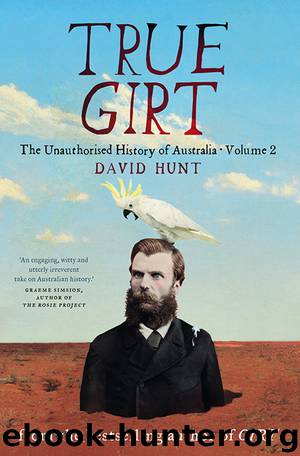True Girt - The Unauthorised History of Australia, Volume 2 by David Hunt

Author:David Hunt
Language: eng
Format: epub, mobi
Publisher: Schwartz Publishing Pty. Ltd
Fawkner, despite condemning drunkenness, fought to maintain his position as Port Phillip’s principal liquor retailer. On one occasion he returned to Launceston on business and left his hotel in the care of two servants, who promptly handed it over to George Smith, who renamed it the Port Phillip Hotel and pocketed the profits. Smith refused to move out on Fawkner’s return, so Fawkner took over the front parlour by force and threshed his wheat crop there around the clock, making such a din that Smith vacated the premises after several sleepless nights. Fawkner was back in business.
The dispute with Smith was typical of the lawless approach to property in Melbourne’s early days. If you could park yourself on several thousand acres of Kulin land, why couldn’t you squat in another man’s pub?
Fawkner built a second hotel, targeting the prosperous traders and wealthy migrants who were swarming into Melbourne. He fitted it out with fancy furnishings, served rum and water at an exorbitant shilling a glass, and installed Melbourne’s first library in an annexe to the bar. Fawkner marketed the experience as “Mental and Bodily refreshment unrivalled in this quarter of the globe”, with a sign inviting drinkers to browse “a very choise Siliction of books”.
Fawkner’s new clientele were very different to the earlier settlers who drank in his first pub. Although Melbournians like to portray themselves as the children of free enterprise, with their gilded city untarnished by convictism, this is a load of old cock.
Melbourne’s settlers were, for the first eighteen months, almost exclusively Tasmanians, many of whom were ex-convicts seeking a place to reinvent themselves. Tasmanians would outnumber other Australian arrivals two to one until 1839, with the Sydney Gazette describing them as “a drunken, worthless set, and a complete pest to the place”.
Despite the Port Phillip Association’s dream of keeping Melbourne convict-free, thirty criminals arrived from Sydney in 1836 and further boatloads followed. Nor were the mothers of Melbourne all formidable dowagers with stately homes, as their descendants suggest – some were “contraband ladies”, Tasmanian convict women smuggled across the strait in beer barrels.
Melbourne underwent a demographic shift in 1839, when John Dunmore Lang’s Scottish immigration program kicked into full gear. Niel Black, who arrived from Argyllshire later that year to establish a squatting empire, marvelled that Melbourne was “a Scotch colony – two thirds of the inhabitants are Scotch”.41
Fawkner sold his hotel interests in 1839 to devote himself to his newspaper, which ran frequent stories on immorality and inebriation. The publican turned temperance campaigner printed the names of convicted drunks and reported on the “incessant depravities” of the wealthy young squatters of the Melbourne Club.
Today the Melbourne Club is noted for its air of staid refinement, Pimm’s & lemonade, blue ties and captains of industry whose decaying flesh is the same colour as the marble busts that adorn its reading room, heritage courtyard garden and bootblack’s cubicle.42
But the Melbourne Club of 1839 was a beast of a different pinstripe. The club’s young pastoralists drank vast quantities of brandy, rather than rum or champagne.
Download
True Girt - The Unauthorised History of Australia, Volume 2 by David Hunt.mobi
This site does not store any files on its server. We only index and link to content provided by other sites. Please contact the content providers to delete copyright contents if any and email us, we'll remove relevant links or contents immediately.
The Memory Code by Lynne Kelly(2353)
Schindler's Ark by Thomas Keneally(1829)
Kings Cross by Louis Nowra(1750)
Burke and Wills: The triumph and tragedy of Australia's most famous explorers by Peter Fitzsimons(1388)
The Falklands War by Martin Middlebrook(1346)
1914 by Paul Ham(1314)
Code Breakers by Craig Collie(1221)
Paradise in Chains by Diana Preston(1217)
A Farewell to Ice: A Report from the Arctic by Peter Wadhams(1210)
Watkin Tench's 1788 by Flannery Tim; Tench Watkin;(1208)
Burke and Wills by Peter FitzSimons(1206)
The Secret Cold War by John Blaxland(1187)
The Protest Years by John Blaxland(1177)
THE LUMINARIES by Eleanor Catton(1127)
30 Days in Sydney by Peter Carey(1124)
The Lucky Country by Donald Horne(1114)
Lucky 666 by Bob Drury & Tom Clavin(1110)
The Land Before Avocado by Richard Glover(1082)
Not Just Black and White by Lesley Williams(1049)
